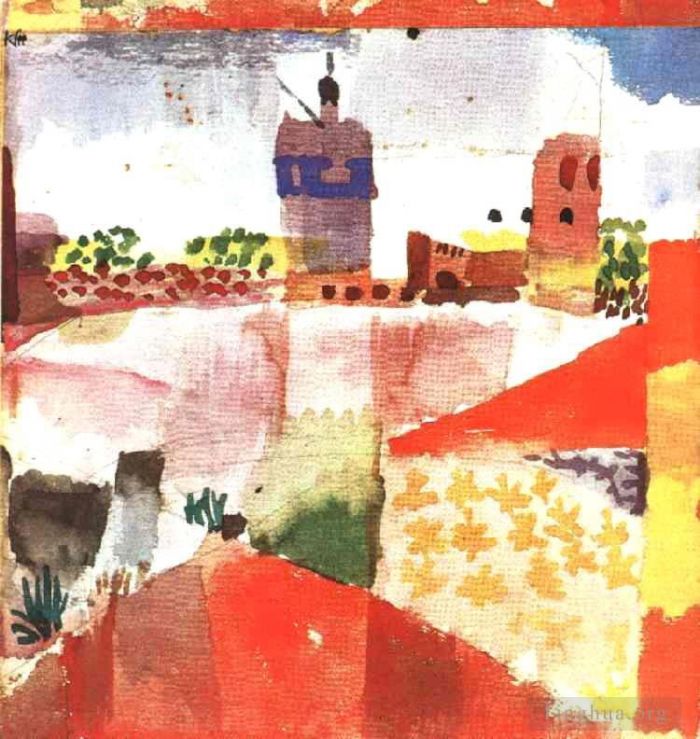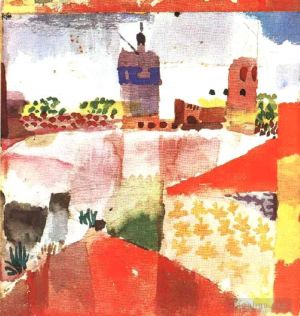Hammamet with mosque
Paul Klee
- Price: Price on Request
- Art Type: Various Paintings
- Size:
- English Comments: 0
- International Comments: 0
- Creating Date:
- Introduction and Works of Paul Klee >>
Work Overview
- Hammamet with Its Mosque
Artist: Paul Klee (German (born Switzerland), Münchenbuchsee 1879–1940 Muralto-Locarno)
Date: 1914
Medium: Watercolor and graphite on paper mounted on cardboard
Dimensions: 9 3/8 × 8 3/4 in. (23.8 × 22.2 cm)
Klee's artistic training, which began in 1898, when he went to Munich for three years to learn to draw and paint, can be said to have lasted until 1914, when he visited Tunisia. The light of North Africa aroused in him a sense of color, and there Klee made his now-famous statement: "Color and I are one. I am a painter."
On April 14, 1914, Klee visited Hammamet, a small town on the Mediterranean, northwest of Tunis. He captured a view of the city in Hammamet with Its Mosque, a watercolor painted from outside the city walls. As happens so often in Klee's works, the picture consists of representational as well as nonrepresentational elements. The upper part shows the mosque surrounded by two towers and gardens; the lower area is made up of translucent color planes, following Robert Delaunay's (1885–1941) example of making pure color and its contrasts the sole subject of a picture.
With Heinz Berggruen's gift of ninety works by Paul Klee, the Museum became an important center for the study of the artist. The outstanding examples that Berggruen gathered span Klee's entire career, from his student days in Bern during the 1890s until his death in 1940. Comprehensive in its variety and extraordinary in its quality, The Berggruen Klee Collection comprises eleven oil paintings, seventy-one watercolors, and eight black-on-white drawings.
- Copyright Statement:
All the reproduction of any forms about this work unauthorized by Singing Palette including images, texts and so on will be deemed to be violating the Copyright Laws.
To cite this webpage, please link back here.
- >> English Comments
- >> Chinese Comments
- >> French Comments
- >> German Comments
- >>Report
- The rumors
- Chinese porcelain
- Bandit head
- WI In Memoriam
- Women in their Sunday best
- Southern Gardens Expressionism Bauhaus Surrealism
- Pierrot Lunaire
- Cat and Bird
- After the floods
- Mountain Village Autumnal
- Red Balloon
- Hamamet
- Siblings
- Full moon
- Struck from the List
- A young ladys adventure
- Aroundfish
- Coming to bloom
- Fire Full Moon
- The Lamb
- Rose garden
- Gauze
- Neuer Stadtteil in M
- Seventeen
- A swarming
- The Chapel
- Chosen Site
- Magdalena before the conver
- Hesitation
- Southern Tunisian gardens
- Senecio
- Characters in yellow
- Park of Idols 193Expressionism Bauhaus Surrealism
- Growth of the night plants
- Little Tree Amid Shrubbery
- Glass Facade
- Heroic Roses
- A woman for Gods
- Tropical twilight
- The vase
- Fire evening
- The column
- The Light and So Much Else
- Villa R
- Woman in Peasant Dress
- Fish Magic
- Six species
- City Picture with Red and G
- With the Egg
- Halme
- Still Life with Thistle Bloom
- Refuge
- Black Knight
- Strong Dream
- Women Pavilion
- Still Life with Dove
- Cosmic Composition
- Ancient Sound Abstract on Black 192Expressionism Bauhaus Surrealism
- The Goldfish
- Child and aunt
- Two country houses
- Summer houses
- The place of the twins
- Flora on sand
- Hammamet with mosque
- City of Churches
- Untitled
- Battle scene from the comic fantastic opera
- Historic ground
- The Mask with the Little Fl
- Oriental Architecture
- Love Song by the New Moon
- This flower wishes to fade
- Contemplation
- Ravaged land
- Harbour with sailing ships
- Station L 112
- The Future Man
- In the current six threshol
- Structural II
- Forest Witch
- Analysis of diverse pervers
- Once Emerged from the Gray of Night
- Cote de provence
- Landscape with Sunset
- Hoffmanneske scene
- Hammamet
- Flower stand with watering can and bucket
- View Towards the Port of Ha
- Rising Sun
- Reconstructing
- Red waistcoat
- Ad Parnassum
- Possessed girl
- Pious northern landscape
- Bad band
- In the houses of St Germain
- Flora on rocks Sun
- Small Landscape with the village church
- Rhythmic Rythmical
- Transparent in perspective Grooved
- Dream City Expressionism Bauhaus Surrealism
- Head of a child
- Colour Shapes
- Revolution of the Viaduct
- Monument
- Mess of fish
- Likeness in the bower
- Boats in the Flood
- Rock Chamber
- Legend of the Nile 193Expressionism Bauhaus Surrealism
- Park Bei Lu
- Sparse foliage
- Promenade in the Orient
- Highway and Byways 192Expressionism Bauhaus Surrealism
- In the Quarry
- A pressure of Tegernsee
- The Travelling Circus
- Embrace 193Expressionism Bauhaus Surrealism
- Before the snow
- Botanical Theater
- Swamp legend
- Phenix
- Asian entertainers
- Place signs
- Captive 194Expressionism Bauhaus Surrealism
- Dream City
- Rising Star
- Flower myth
- Still life
- Angel Still Feminine
- Foehn Wind in Marc Garden
- Destroyed place
- Witch scene
- Death and fire
- At the Core
- Castle Garden
- Remembrance of a Garden 191Expressionism Bauhaus Surrealism
- Error on green
- Stage Landscape
- Puppet theater
- The last of the mercenaries
- Evening shows
- Pastoral Rhythms
- Cacodemonic
- Remembrance of a Garden
- Houses near the Gravel Pit
- An allegory of propaganda
- Landscape with Yellow Birds
- Fish Image
- A kind of cat
- Garden Figure
- Bird Wandering Off
- Enlightenment of two Sectie
- The messenger of autumn
- Fruits on Red
- Windows and palm trees
- Oriental Garden
- Revolving House
- In the Style of Kairouan
- Southern Tunisian Gardens 191Expressionism Bauhaus Surrealism
- Clouds over Bor
- Flowers in Stone
- Crystal
- With the Setting Sun
- Tale of Hoffmann
- Diana in the Autumn Wind
- Wall Painting from the Temple of Longing
- Red and White Domes 191Expressionism Bauhaus Surrealism
- Part of G
- Mumon drunk falls into the chair
- Insula Dulcamara 193Expressionism Bauhaus Surrealism









 Singing Palette
Singing Palette